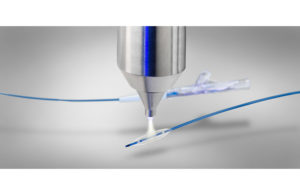Surface treatment to prepare medical device components for printing or bonding may require complex cleaning methods or harmful chemicals. Plasma etching for improved adhesion, once limited to low-pressure chambers, is now available at atmospheric pressure.
Erhard Krampe, Plasmatreat

Conventional methods of surface preparation, treatment and modification of medical devices made of PTFE, FEP and polyamide are usually expensive, harmful and very limited in their application range. Plasma treatment offers two processes as alternatives.
One operates with low-pressure plasma and enables surface pretreatment of a single or a large number of products in a batch process. In this case, a homogeneous treatment of the entire surface takes place in a low-pressure chamber. The other process allows for rapid, continuous treatment of a product within the production line under atmospheric pressure.
Both plasma processes use process gases that are converted into an excited state. The excited molecules, ions and free electrons interact on contact with surfaces such as rubber, metal, plastic or ceramic and change the surface chemistry.
Deep-cleaning fluoropolymers
The fluoropolymers used in manufacturing catheters are largely resistant to conventional surface treatment methods, normally requiring extreme chemical treatment, such as sodium etching. This method is environmentally harmful and expensive and may require the application of an additional primer or bonding agent and discoloration of the material, which is problematic for maintaining product aesthetics.
In contrast, plasma pretreatment gently and reliably removes parting agents and organic contaminants from surfaces and subjects them to ultra-fine cleaning. During the same process step, plasma activation can also be carried out to enable adhesives and coatings to adhere later.
Low-pressure plasma etching can remove contamination from the surface of PTFE in a targeted manner using defined process gases at the nanometer level. In a next step, the removal of functional layers allows the PTFE to be optimally prepared for permanent connections within a certain time window. Since this process is carried out under vacuum and with neutral gases, it is much more environmentally friendly and also much easier to handle.
A recent study compared the adhesive bonding of the fluoroplastics FEP and PFA after plasma modification and after tetraetching. As expected, at the beginning almost no adhesion was achieved on an untreated surface. Both the tetra-etched and the plasma-treated samples showed a significant improvement in adhesion strength. The introduction of cost-effective plasma processes using a low-pressure or open-air plasma system, depending on the application, has largely eliminated the use of harmful chemicals, which has significantly reduced the amount of toxic process waste.
COVID-19 test applications
The same process attributes of plasma surface treatment may be used in other medtech applications, including the treatment of test kits for COVID-19. Demands for greater efficiency of these test processes are constantly increasing, including a requirement to use as little analysis substrate as possible to minimize the costs of individual tests.
This can be achieved by a hydrophobic surface coating applied specifically in the area of the test that comes into contact with liquid. Super-hydrophobic coating, which is applied locally by an open-air plasma system, meets this requirement. These coatings, which are only nanometers thick, also fulfill the highest analytical demands with regard to optical transparency and sealing.
As a dry cleaning technology, plasma processes replace costly manual or wet-chemical/solvent-based cleaning processes, thereby meeting increasing demands for reducing volatile organic chemicals during manufacturing. At the same time, they reduce cycle times. The surface properties can be customized for different purposes, such as adhesive, oleophobic/oleophilic, hydrophobic/hydrophilic and other desired functionalities.
Erhard Krampe is head of Plasmatreat Academy & Market Segment Management Medical Technology at Plasmatreat (Steinhagen, Germany). Krampe completed his studies in Medical Technology at the Technical University of Munich and at the RWTH Aachen – Institute for Plastics Processing.
The opinions expressed in this blog post are the author’s only and do not necessarily reflect those of Medical Design and Outsourcing or its employees.

